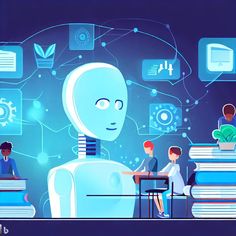
Introduction
Imagine you've signed up for an online course, eager to expand your knowledge. But upon logging in, you're met with static text blocks and monotonous lectures. Clicking through slide after slide, you struggle to stay focused, and the initial excitement quickly fades. This scenario, unfortunately, represents a common pitfall in online learning – a lack of engagement that leads to frustration and, ultimately, course abandonment.
Online learning has exploded in popularity, offering flexibility and convenience for students worldwide. However, keeping learners engaged and motivated can be a significant challenge. Studies reveal high dropout rates and low completion percentages, highlighting the need for improvement.
Optimizing online learning experiences is crucial for maximizing educational outcomes. When learners are engaged, they retain information more effectively, develop deeper understanding, and are more likely to complete the course. This translates to achieving their learning goals, acquiring valuable skills, and ultimately, reaping the benefits of online education.
By implementing online learning optimization strategies, we can transform online courses from passive experiences into dynamic and engaging environments that foster increased engagement and improved learner retention.
This article is a roadmap for educators and course designers. We'll delve into practical strategies for optimizing online learning experiences. By incorporating interactive elements, catering to diverse learning styles, and fostering a sense of community, we can create online courses that are informative but also captivating and effective in retaining learners throughout their educational journey.
Understanding Learner Needs and Preferences

The Learner-Centered Approach: A Shift in Paradigm
Traditional online courses often resembled static textbooks translated into a digital format. Instructors delivered information with minimal interaction, leaving learners feeling like passive recipients rather than active participants. Thankfully, a significant shift has occurred towards learner-centered design. In this approach, the focus flips entirely. The course is designed and developed to meet the audience's specific needs, preferences, and learning styles. This learner-centric approach leads to a more engaging and practical learning experience, increasing knowledge retention and successful course completion.
Identifying the Learner Landscape
The first step in optimizing online learning is to understand your learners. Here are some key methods to uncover their needs and preferences:
- Pre-Course Surveys: Before the course begins, send out surveys to gather valuable information. These surveys can inquire about learners' prior knowledge of the subject matter, their experience with online learning platforms, their preferred learning styles (discussed further below), and, most importantly, their motivations and goals for taking the course. Understanding these motivations allows you to tailor course activities and assessments to align with their aspirations, fostering a sense of relevance and boosting engagement.
- Diagnostic Assessments: Online quizzes or short assessments can gauge learners' current knowledge level. This helps identify areas where they might need additional support or, conversely, topics where they already possess a strong foundation. Tailoring the pace and difficulty of the course based on this data prevents frustration and wasted time for learners of all levels.
- Interviews (Optional): While only sometimes feasible with large student populations, conducting individual interviews (in-person or online) with a representative sample of learners provides even deeper insights. These interviews can delve into specific challenges learners anticipate, their preferred learning approaches, and any learning anxieties they might have.
Learning Analytics: Data-Driven Insights

Modern online learning platforms offer potent tools known as learning analytics. These tools track learner activity within the course, providing valuable data on how they interact with content, complete assignments, and progress through the course material. By analyzing this data, instructors can gain insights into learner behaviour, identify prevalent learning styles, pinpoint areas where students might struggle, and assess overall engagement levels.
By combining information from pre-course surveys, diagnostic assessments, interviews (if conducted), and learning analytics, instructors can gain a comprehensive understanding of their learners' needs, which can be broadly categorized into three key areas:
- Prior Knowledge and Experience: Knowing learners' existing knowledge base helps tailor content difficulty and avoid redundancy for those with a strong foundation.
- Learning Styles and Preferences: People learn and process information in distinct ways. Understanding these variations is crucial for effective course design.
- Motivations and Goals for Taking the Course: Tapping into learners' motivations allows for creating course activities and assessments that are directly relevant to their desired outcomes, increasing engagement and boosting the perceived value of the course.
Catering to Diverse Learning Styles: A Multifaceted Approach

Individuals learn and retain information through different channels. Some are visual learners who thrive on images, diagrams, and videos. Auditory learners benefit from lectures, podcasts, and discussions. Kinesthetic learners require hands-on activities and simulations to solidify their understanding.
Online learning optimization necessitates presenting information in various formats to cater to these diverse learning styles.
- For Visual Learners: Include engaging visuals like infographics, charts, diagrams, screenshots, and concept maps.
- For Auditory Learners: Offer audio lectures, podcasts, opportunities for audio recordings of presentations or discussions, and even the option for audio note-taking.
- For Kinesthetic Learners: Incorporate interactive activities, simulations, role-playing exercises, case studies, and hands-on projects.
Designing for Accessibility: No Learner Left Behind
It's crucial to make online learning materials accessible to learners with disabilities. These include:
- We are providing text transcripts for audio recordings and captions for videos.
- We are ensuring proper color contrast for text and backgrounds to meet accessibility guidelines.
- We offer alternative text descriptions for images, conveying the image's content to users relying on screen readers.
- Making all course materials compatible with screen reader software allows learners with visual impairments to access the information.
By prioritizing accessibility, we ensure that all learners have the opportunity to participate and succeed in online learning environments. These foster a more inclusive learning experience and expand the reach of online education.
Strategies for Increased Engagement: Keeping Learners Captivated
The key to successful online learning is keeping participants actively involved and enthusiastic. Here are some effective strategies to boost engagement in online courses:
1. Interactive Content and Activities:
Passive lectures and static text blocks quickly lead to disengagement. Interactive content keeps learners actively involved in the learning process. This can include:
- Quizzes and polls: These quick assessments allow learners to test their understanding, receive immediate feedback, and identify areas needing further exploration.
- Discussions and forums: Creating online forums allows for peer-to-peer interaction, fostering community and encouraging learners to share insights and ideas.
- Simulations and case studies: Interactive simulations allow learners to apply their knowledge in realistic scenarios, boosting comprehension and critical thinking skills.
2. Microlearning and Chunking Content:
Adult learners often have busy schedules and struggle to concentrate for extended periods. Microlearning addresses this by separating information into smaller, more manageable chunks (e.g., 5-10 minutes each). This bite-sized approach makes learning more digestible, reduces cognitive overload, and improves knowledge retention.
3. Gamification in Online Learning:
Gamification leverages the power of game mechanics like points, badges, and leaderboards to motivate learners and inject a healthy dose of competition into the learning experience. Here are some ways to gamify online learning:
- Awarding points for completing activities or achieving milestones.
- Offering badges for mastering specific skills or concepts.
- Implementing leaderboards to foster friendly competition among learners.
4. Social Learning and Collaboration:
Humans are social creatures who learn effectively from interaction and collaboration. Social learning opportunities in online courses can take various forms:
- Online forums: As mentioned earlier, online forums provide a platform for learners to discuss course topics, ask questions, and share insights with peers.
- Group projects: Collaborative projects allow learners to work together on assignments, develop teamwork skills, and learn from each other's perspectives.
- Peer feedback: Implementing peer review exercises encourages learners to provide constructive feedback to their peers, which can solidify their understanding and enhance critical thinking skills.
5. Storytelling and Case Studies:
Facts and figures are essential, but weaving compelling narratives into your course content can significantly enhance engagement.
- Storytelling: Use real-world stories, historical anecdotes, or even fictional scenarios to illustrate key concepts and make them more relatable to learners.
- Case studies: Present real-life scenarios relevant to the course content. Learners can analyze these cases, propose solutions, and learn from the successes and failures of others.
By incorporating these strategies, online courses can transform from static content repositories into dynamic and engaging environments that keep learners captivated, motivated, and actively participating in the learning process.
Strategies for Improved Retention: Ensuring Knowledge Sticks
Engagement is crucial, but it's only half the battle. The ultimate goal is for learners to retain the knowledge and skills acquired throughout the course. Here are some strategies to solidify learning and improve learner retention:
1. Clear Learning Objectives and Expected Outcomes:
The cornerstone of effective learning lies in establishing clear expectations. At the outset of the course, explicitly define the learning objectives. These objectives outline the knowledge and skills learners will gain by the course's end. Additionally, communicate the expected outcomes. This clarifies what learners should be able to do with their acquired knowledge, such as applying it to solve problems, make informed decisions, or perform specific tasks.
2. Effective Assessment and Feedback:
Assessment goes beyond simply measuring learner performance at the end of the course. Formative assessments – quizzes, polls, and short assignments – integrated throughout the course provide valuable insights into learner understanding. This allows instructors to identify areas of difficulty early on and adjust their teaching approach accordingly. Summative assessments, like final exams or projects, gauge overall learning and achievement of the course objectives.
The key to practical assessment lies in providing timely and constructive feedback. Feedback should be specific, actionable, and focused on helping learners improve their understanding and performance.
3. Scaffolding and Personalized Learning Paths:
Scaffolding involves providing targeted support to learners as they progress through the course material. These can take the form of:
- Providing clear instructions and examples
- Breaking down complex concepts into smaller, more manageable steps
- Offering additional resources like video tutorials or glossaries
Personalized learning paths take this further by tailoring the learning experience to individual needs and learning styles. This might involve providing additional resources for learners who need more support or offering enrichment activities for those who grasp concepts quickly.
4. Creating a Community of Learners:
Humans are social creatures who learn effectively through interaction. Fostering a sense of community in online courses promotes engagement and knowledge retention. Techniques include:
- Encouraging online discussions where learners can share ideas, ask questions, and learn from each other's perspectives.
- Facilitating group projects that require collaboration and peer-to-peer learning.
- Creating online forums where learners can connect and build relationships with their peers.
5. Effective Communication and Support:
Clear and consistent communication is essential. Regularly communicate course updates, deadlines, and expectations to learners. Provide readily accessible support resources such as FAQs, video tutorials, and a dedicated help desk for learners to address concerns.
By implementing these strategies, online courses can transform from passive experiences to active learning environments that promote knowledge retention and ensure learners walk away with valuable skills and a deeper understanding of the subject matter.
The Role of Technology in Online Learning Optimization
Technology plays a vital role in optimizing online learning experiences. Here's how various tools can enhance the learning journey:
- Learning Management Systems (LMS): These platforms provide a centralized hub for course content, assessments, communication tools, and learner progress tracking. LMS features like discussion forums and assignment dropboxes facilitate interaction and collaboration.
- Collaborative Tools: Online tools like video conferencing platforms, shared document editing software, and real-time chat applications enable effective collaboration among learners and instructors.
- Mobile Learning Apps: The ability to access course materials and complete learning activities on mobile devices fosters flexibility and caters to learners with busy schedules.
Emerging technologies like Virtual Reality (VR) and Augmented Reality (AR) hold immense potential for online learning. Imagine exploring historical events in VR simulations or manipulating 3D models of anatomical structures in AR. These technologies can create immersive learning experiences that enhance engagement and knowledge retention.
However, limitations exist. VR and AR require specialized equipment that can be cost-prohibitive for some learners. Additionally, developing high-quality VR/AR learning experiences requires significant resources. Despite these limitations, these technologies have the potential to revolutionize online learning in the future.
Conclusion: A Brighter Future for Online Learning
This exploration has shed light on many strategies for optimizing online learning experiences. We've emphasized the importance of understanding learner needs and catering to diverse learning styles through interactive content, microlearning, and engaging formats. Fostering increased engagement through gamification, social learning, and storytelling keeps learners motivated and actively participating. But engagement is just one piece of the puzzle. Effective online learning environments prioritize improved retention through clear learning objectives, formative assessments, and personalized learning paths. Additionally, fostering a sense of community and providing consistent communication and support are crucial for learner success.
By leveraging these strategies and the power of technology like learning management systems and collaborative tools, online learning can be transformed into a dynamic and effective educational tool. Increased engagement translates to a more enjoyable learning experience for students, while improved retention ensures they gain valuable knowledge and skills. This also benefits educators by providing them with more successful learners and a more fulfilling teaching experience.
The future of online learning is bright. We can expect even more innovative and immersive learning environments as technology evolves. The ongoing efforts to develop engaging and effective online learning experiences hold the potential to democratize education and make high-quality learning accessible to a wider audience than ever before.